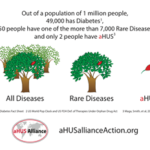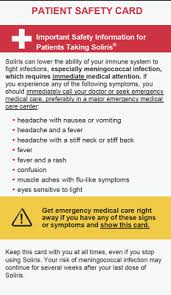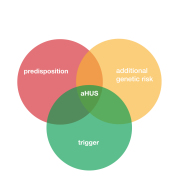aHUS epidemiology is the about how many aHUS patients there are. The numbers onsetting and surviving. It’s “Incidence” and “prevalence”.
How many aHUS patients are there in my local area, my country and the world and how do they differ?
Our expert told us :
” Epidemiology of atypical hemolytic uremic syndrome (aHUS) patients can vary significantly by region, country, and globally. Here are some key points to consider:
Local Area: The prevalence of aHUS patients in a specific local area, such as a city or region, is generally influenced by population size and healthcare access. The number of aHUS cases in a local area may be relatively low.
Country: The prevalence of aHUS patients within a country depends on factors like population size and genetics. In larger countries, you may find more aHUS patients in absolute numbers, but the prevalence rate (the number of cases per population) may still be relatively low.
World: aHUS is considered a rare disease, and its prevalence worldwide is relatively low. The number of aHUS patients globally is estimated to be in the thousands, making it a rare condition compared to more common diseases.
Key Differences:
- Genetic Variability: aHUS is associated with genetic mutations in the complement system. The specific genetic mutations can vary between patients, leading to differences in disease severity and progression.
- Environmental Factors: Environmental factors, such as infections or other triggers, can play a role in the development and course of aHUS. These factors can differ by region or country.
- Healthcare Access: Differences in healthcare systems and access to specialized care can impact the diagnosis and management of aHUS patients in various regions.
- Treatment Availability: The availability of specific aHUS treatments, such as complement inhibitors, may vary by country and region.
It’s important to work with healthcare professionals and patient advocacy organizations to gain a better understanding of aHUS within your specific area and to access support and information tailored to your needs. Additionally, data on the prevalence of aHUS is subject to change as more research is conducted and more patients are diagnosed.”
Our experts response is not unexpected. The answer is no one knows the exact epidemiology or if they do the records are not published anywhere. Of course the reasons given for there being a difference in numbers around the world are valid and they are what making estimates of aHUS numbers , based on assumptions, difficult.
Where diagnosis and treatment is not so good particularly for adults, numbers are relatively low per million of the population and where it is good particularly for children, it is several times higher.
For arguments sake let’s use 2 per million and 10 per million respectively for the worst and best prevalence scenarios, In a world population of 8 billion then globally there could be between 16000 and 80000 surviving aHUS patients world. The actual number is in there somewhere and is as accurate an epidemiology as research allows. Probably towards the lower level as the bulk of the world aHUS patient have no access to complement inhibitors.
The viewer can do the same with their city, state or country just apply the rates per million to the relevant population.
For example Los Angeles has a population of 10 million so the prevalent aHUS population is between 20 and 100. Probably more towards the 100 than the 20.
California has a population of 39 million so aHUS prevalence is between 78 and 390.
In the USA with a 330 million population it is between 660 and 3300 living with aHUS.
So most likely over 300 and around 3000 aHUS patients in California and USA respectively. You get the idea.
All patients differ. Some have known complement genetic mutations some have none found. The patients with mutations will differ because of the location of their genetic mutations across the range of complement components. Where national data is published there can be different mixes between one country and another and between geographical regions.
Does epidemiology matter? Do we need to know how many there are?
For the individual who wants to know how rare they are maybe . Rare disease status is helpful to patient groups when it comes to support for orphan drugs. Manufactures would need to make assumptions about potential sales and distribution. Surviving patients numbers may be an indicator of progress if patient numbers are increasing.
It is known that aHUS is well within the limits of what constitutes a rare disease even at the higher prevalence assumption.
Also at a current aHUS incidence rate of around 165 per year it is impossible to exceed 200,000 rare disease threshold in the USA unless all survivors live for 1200 years!
This article concludes the series of 16 articles about the patient research agenda which have been published since the beginning of December last year. Shortly there will be a summary article on the state of play for the whole agenda and progress made. Then a decision of what the aHUS patient community does next will be needed.
Article No. 638
Previous articles about aHUS patient numbers and charactristics:

Numbers about aHUS
The first thing about aHUS numbers is that there is no exact record of global aHUS patients anywhere . But research on the universal characteristics of all aHUS patients tend…

Again, just how many aHUS patients are there?
Article No. 369 12 August 2020 Recently when preparing an article about USA aHUS patient numbers ( see Article 362 ) an article appeared in a Google search that had…
CONTINUE READINGAgain, just how many aHUS patients are there?

USA aHUS Patients-2000 or more and rising?
Article No. 362 27 July 2020 Ask Google ” how many aHUS patients are there in the USA?” and you will not get an exact answer. Understandable really, as there…

Are Chinese aHUS Patients different?
Article No 385 7 October 2020 Apart from wanting to know how many ( prevalence of ) aHUS patients there are in their country, another question asked by aHUS patients…

Are there 3000 aHUS patients in the USA
Health care and better estimating lead us to believe there are approaching 3000 aHUS patients in the USA who have survived their encounter with their disease, if not already 3000.…
CONTINUE READINGAre there 3000 aHUS patients in the USA

Iceland and aHUS
Nearly 400,000 people live in Iceland. At normal prevalence levels there should be two aHUS patients. There are at least three in Iceland. They are all in one family. The…
CONTINUE READINGIceland and aHUS

Is incidence of aHUS really “2 per million”?
I know it should not matter so much but whenever I see incidence and prevalence figures for aHUS in articles etc, it often “does my head in”. Quite some confusion…


